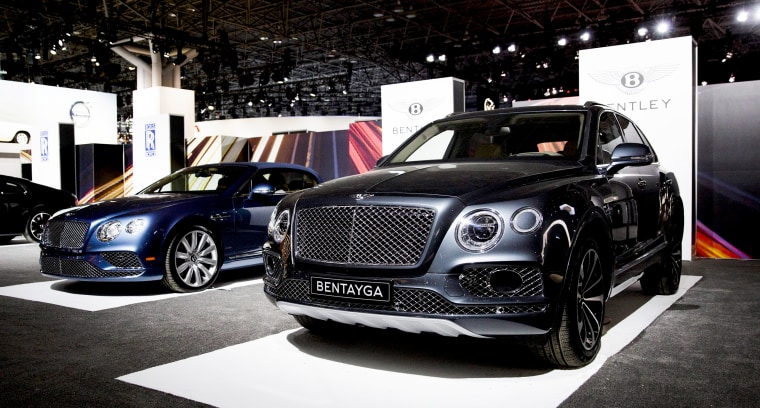As much as might be possible for a car costing over $250,000 and making more than 600 horsepower, the Bentley Continental GT Speed is a relatively subdued vehicle. Not so the new 2017 Bentley Bentayga sitting alongside it at the Lime Rock race track in the middle of hilly Connecticut, two hours north of New York City during a preview for automotive journalists.
Unabashedly bold, the Bentayga is being billed as “the fastest, most powerful, most luxurious, most exclusive SUV in the world.” Add “most expensive.” When the new model starts rolling into U.S. showrooms in a couple months, it will carry a base price of $229,100. Add the long list of accessories and some buyers are likely to double that figure. An optional Breitling clock alone is listed at $160,000.
Read More: SUVs Snag the Spotlight at New York Auto Show
How long Bentley will be the most expensive SUV — or the fastest and most powerful, for that matter — remains to be seen. Within the next few years, a Who’s Who list of the world’s most exclusive automotive manufacturers will be launching SUVs of their own, including the likes of Lamborghini, Aston Martin and even Rolls-Royce.
The idea of a Rolls SUV might seem a little unlikely until one considers what’s happening across the automotive market. Even as U.S. auto sales surge to record levels, the market share of so-called light trucks, including pickups, minivans and SUVs, has also climbed to an all-time high.
The shift is happening at every price level, from entry level to the market’s most rarefied segments. Indeed, Bentley is so confident about the prospects for the Bentayga that it expects it will soon be the best-selling model in the British marque’s history. The same is true for Aston, which is working up a production version of the DBX sport-ute concept it revealed last year, and for Maserati, which expects to sell as many as 30,000 of its new Levante SUVs annually — roughly doubling its global sales.
“These days, if you ask buyers, more and more associate luxury with functionality,” says Enrico Billi, the Levante’s product manager.
Nowhere has that been more obvious than at Porsche. It set skeptics’ tongues a-wagging when, shortly before the dawn of the new millennium, the company announced plans to add an SUV alongside familiar sports cars like the 911. But these days, the Cayenne is the brand’s most popular model and, analysts will tell you, the critical key to Porsche’s current global success. It recently added a second, slightly smaller model, the Macan, and can barely keep up with demand.
That set up a race among mid-luxury competitors like Audi, BMW and Mercedes-Benz to add utes of their own. The Mercedes SUV line-up has become so big that the German maker recently had to rechristen much of the mix so potential buyers could tell them apart.
Read More: Buick (Yes, Buick) Crack Top Auto Brands Ranking
Porsche actually wasn’t the first in the luxury SUV space. Between 1986 and 1993, Lamborghini offered the ground-shaking LM002, widely known as the “Rambo Lambo.” It only sold 328 of them, but Lamborghini’s so confident about the upcoming Urus model that it is doubling the size of its operations in the Modena suburb of Sant’Agata, Italy, while adding another 500 jobs
The SUV, set to debut in 2018, will be “crucial for the success of the company. We need to be present in a growing segment that is becoming very well distributed all over the world,” said the former Lambo CEO who approved the project before shifting to sibling luxury brand Audi early this year.
The one high-line brand clearly identified with SUVs is Land Rover, though its early products were more likely to be found on farms or slogging through mud in third-world markets. Today, it offers products like the Range Rover Long-Wheelbase Autobiography Black Holland & Holland edition. Fully loaded, the limited-edition model went for$285,000.
For years, sibling British brand Jaguar was content to let Land Rover handle the SUV side of the market. Bowing to the sharp shift in global demand, it’s launching its own utility vehicle, the F-Pace, this year. And it’s likely to become that maker’s best-seller, as well.
With the exception of Land Rover’s products, and a few other extreme entries like the big Cadillac Escalade, Lincoln Navigator, and Mercedes G-wagen, it’s something of a misnomer to call these new SUVs “trucks.” They’ve largely abandoned classic body-on-frame, or “truck-truck” designs for more car-like unibody platforms.
That’s no surprise. Relatively few luxury buyers will ever drive down anything rougher than a gravel road leading to their getaway cottages. But these modern utes offer notably better on-road manners and, if it were to matter to the most affluent of car buyers, notably better mileage.
Read More: Google, Fiat Chrysler Team Up to Develop Autonomous Vehicles
Actually, there’s a growing interest in green technology, even among the wealthiest motorists. Tesla can barely keep up with demand for its new, all-electric Model X. Bentley will launch a plug-in hybrid version of the Bentayga next year. And Audi plans to have a pure battery-electric SUV in production in 2018.
There are other reasons why we could see a number of battery-powered luxury SUVs, explains Bentley’s U.S. CEO Michael Winkler. For one thing, luxury makers are already struggling to meet U.S. mileage and European emissions standards. Add the fact, he says, that “Some places around the world, like London, are considering rules that may not let you drive into the city in a car that isn’t electrified.”
One way or the other, luxury makers are looking to bow to consumer demand. Like mainstream manufacturers, they’re addressing a seismic change in the market place as buyers abandon traditional sedans, coupes and sports cars in favor of sport-utility vehicles whatever the price.
